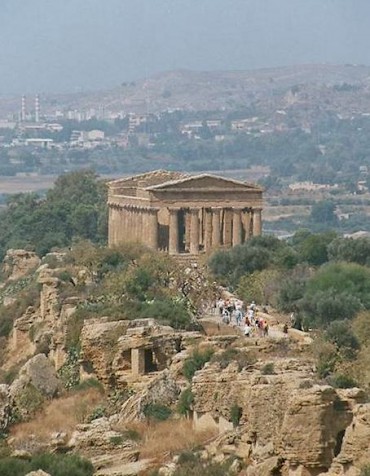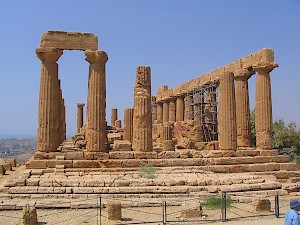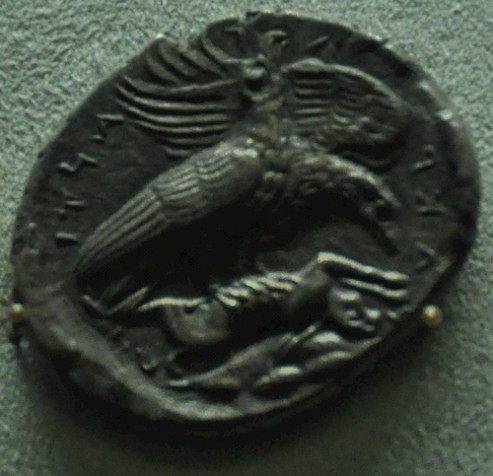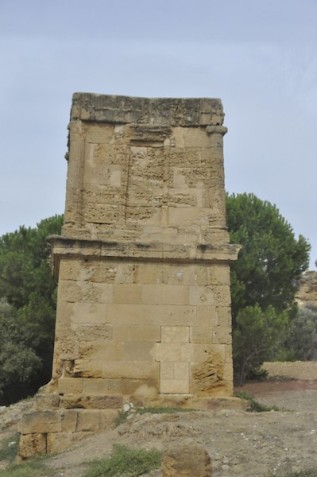Acragas (Agrigento)
Q13678Acragas (Greek Ἀκράγας): Greek town in southern Sicily, modern Agrigento.

Situated more or less in the center of the Mediterranean Sea, Sicily has always attracted visitors, who sometimes stayed. According to the Athenian historian Thucydides, Acragas was founded in 580 BCE by Greek settlers from Gela led by Aristonous and Pystilus.note Archaeological evidence seems that the first Greeks arrived some twenty years earlier.
The first nucleus may have been an older cult center, identified near the sanctuary of the Chthonic Deities. The port must have been important too, but the colony may have been founded in the first place to exploit the agricultural resources of the valleys of the rivers Hypsas and Acragas.

Gela was soon eclipsed by the new town, which rose to great power in the mid-sixth century, when Phalaris, the son of Leodamas of Rhodes, became its tyrant ("sole ruler"). He is credited with succesful wars against the indigenious population, the strengthening of the walls, and the construction of an aqueduct and several other buildings. He also improved trade with Carthage and organized athletic contests. In short, he changed the original settlement into a real city.
In the historical tradition, Phalaris became the prototype of an evil dictator. One of the most famous stories about him is that of the iron (or brazen) bull made by Perilaus of Athens, a well-known bronze-worker. The victims of the tyrant were shut up inside this artifice and then a fire was kindled underneath the bull. The poor prisoner was now roasted alive, and by some sort of acoustic mechanism, the shrieks of his agony resembled the bull's bellowing. The first victim is said to have been Perilaus himself.

The territory of Acragas expanded. Ecnomus (modern Licata) was taken over from the Gelans. At the beginning of the fifth century, the tyrant Theron and his son-in-law Gelon of Syracuse often cooperated, for example in a big war against the Carthaginians. In 480 BCE, they were victorious in the battle of Himera. To celebrate this, Acragas ordered the Carthaginian POWs to built the temple of Zeus.
Acragas was remarkably rich. This can be deduced from the excellent coins and an unusually great number of temples. In 500 BCE, the temple of Heracles was built, followed twenty years later by the Zeus temple mentioned above. The temple of Hera and the so-called temple of Concord were built in c. 450 and c. 430.
The city was famous. The horses of the city's aristocrats were well-known, because they nearly always won at the Olympic Games. When the flutist Midas of Acragas had won a prize in the contests of Delphi, the poet Pindar called "the splendor-loving city Acragas the most beautiful on earth".note On of its most famous citizen was the philosopher Empedocles.

In 416, war broke out between Segesta and Selinus. When the latter was victorious, the first-mentioned city invoked Athenian help, but this expedition ended in disaster. Consequently, the Segestans invited the Carthaginians (410), who came, saw, and conquered. And since they had the largest army anyhow, they proceded to capture Acragas, which was sacked in 406. The prestigious temple of Zeus had never been finished.note The city never recovered, although Timoleon of Syracuse sent colonists in 340.

In 264, the First Punic War broke out, a conflict between Rome and Carthage. After a long war - the longest and biggest conflict in world history, according to Polybius of Megalopolis - the Romans were victorious, and added Sicily to their growing empire.
The capital of Roman Sicily was Syracuse: easier to reach than other cities, including Acragas, which was from now on called Agrigentum. During the Second Punic War, the city was briefly used by the Carthaginians, but in 210 it became Roman, and this time for good.
Agrigrentum was an agricultural center of some importance, with large, slave-run country estates in the neighborhood. It was prosperous, but it never achieved its former splendor again, although Nero's praetorian prefect, Ofonius Tigellinus, was born in the city.
We know that there was a Jewish community, and it is certain that in Late Antiquity, the Christians took over the so-called temple of Concord as a church, which explains why it is so well-preserved.